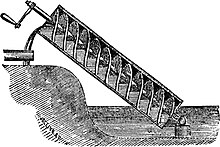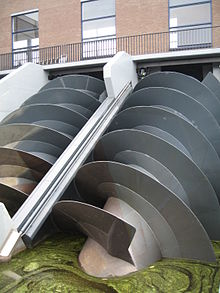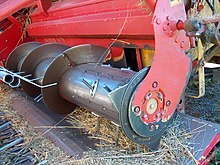Archimedes' screw
This article needs additional citations for verification. (September 2007) |





Archimedes' screw, the Archimedes screw, the Archimedean screw or the screwpump is a machine historically used for transferring water from a low-lying body of water into irrigation ditches. It was one of several inventions and discoveries traditionally attributed to Archimedes in the 3rd century BC.
Design
The Archimedes' Screw consists of a screw inside a hollow pipe. The screw is turned usually by a windmill or by manual labor. As the bottom end of the tube turns, it scoops up a volume of water. This amount of water will slide up in the spiral tube as the shaft is turned, until it finally pours out from the top of the tube and feeds the irrigation systems.
The contact surface between the screw and the pipe does not need to be perfectly water-tight because of the relatively large amount of water being scooped at each turn with respect to the angular frequency and angular speed of the screw. Also, water leaking from the top section of the screw leaks into the previous one and so on, so a sort of mechanical equilibrium is achieved while using the machine, thus preventing a decrease in mechanical efficiency.
The "screw" does not necessarily need to turn inside the casing, but can be allowed to turn with it in one piece. In ancient times people ran on the screw to turn them. A screw could be sealed with Pitch resin or some other adhesive to its casing, or, cast as a single piece in bronze, as some researchers have postulated as being the devices used to irrigate the Hanging Gardens of Babylon, one of the Seven Wonders of the Ancient World. Depictions of Greek and Roman water screws show the screws being powered by a human treading on the outer casing to turn the entire apparatus as one piece, which would require that the casing be rigidly attached to the screw.
The design of the everyday Greek and Roman water screw, in contrast to the heavy bronze device of Sennacherib, with its problematic drive chains, has a powerful simplicity. A double or triple helix was built of wood strips (or occasionally bronze sheeting) around a heavy wooden pole. A cylinder was built around the helices using long, narrow boards fastened to their periphery and waterproofed with pitch[1]
Uses
Along with transferring water to irrigation ditches, this device was also used for reclaiming land from under sea level in the Netherlands and other places in the creation of polders. A part of the sea would be enclosed and the water would be pushed up out of the enclosed area, starting the process of draining the land for use in farming. Depending on the length and diameter of the screws, more than one machine could be used to successively lift the same water.
Archimedes screws are used in sewage treatment plants because they cope well with varying rates of flow and with suspended solids. An auger in a snow blower or grain elevator is essentially an Archimedes screw.
The principle is also found in pescalators, which are Archimedes screws designed to lift fish safely from ponds and transport them to another location. This technology is primarily used at fish hatcheries, where it is desirable to minimize the physical handling of fish.
History
The invention of the water-screw is credited to Archimedes of Syracuse in the 3rd century BC.[2] Its tentative attribution to the 6th century BC Assyrian king Sennacherib by the assyriologist Dalley has been questioned on the grounds of "the total lack of any literary and archaeological evidence for the existence of the water-screw before ca. 250 BC".[3][4] A screw can be thought of as an inclined plane wrapped around a cylinder.
Variants

A screw conveyor is an Archimedes' screw contained within a tube and turned by a motor so as to deliver material from one end of the conveyor to the other. It is particularly suitable for transport of granular materials such as plastic granules used in injection moulding, and cereal grains. It may also be used to transport liquids. In industrial control applications the conveyor may be used as a rotary feeder or variable rate feeder to deliver a measured rate or quantity of material into a process.
See also
Footnotes
- ^ Online copy of Dalley/Oleson article
- ^ Oleson 2000, pp. 242–251
- ^ Stephanie Dalley and John Peter Oleson (January 2003). "Sennacherib, Archimedes, and the Water Screw: The Context of Invention in the Ancient World", Technology and Culture 44 (1).
- ^ Oleson 1984, pp. 292
References
- Oleson, John Peter (2000), "Water-Lifting", in Wikander, Örjan (ed.), Handbook of Ancient Water Technology, Technology and Change in History, vol. 2, Leiden, pp. 217–302 (242–251), ISBN 90-04-11123-9
{{citation}}: CS1 maint: location missing publisher (link) - Oleson, John Peter (1984), Greek and Roman mechanical water-lifting devices. The History of a Technology, Dordrecht: D. Reidel, ISBN 90-277-1693-5
External links
- Technology and Culture Volume 44, Number 1, January 2003 (PDF) Dalley, Stephanie. Oleson, John Peter. "Sennacherib, Archimedes, and the Water Screw: The Context of Invention in the Ancient World"
- The Turn of the Screw: Optimal Design of an Archimedes Screw, by Chris Rorres, PhD.
- Plywood archimedean screw water pump, how to build a functioning Archimedes screw pump
- Manual for Screw Pumps, publisher
- "Archimedean Screw" by Sándor Kabai, Wolfram Demonstrations Project, 2007.
